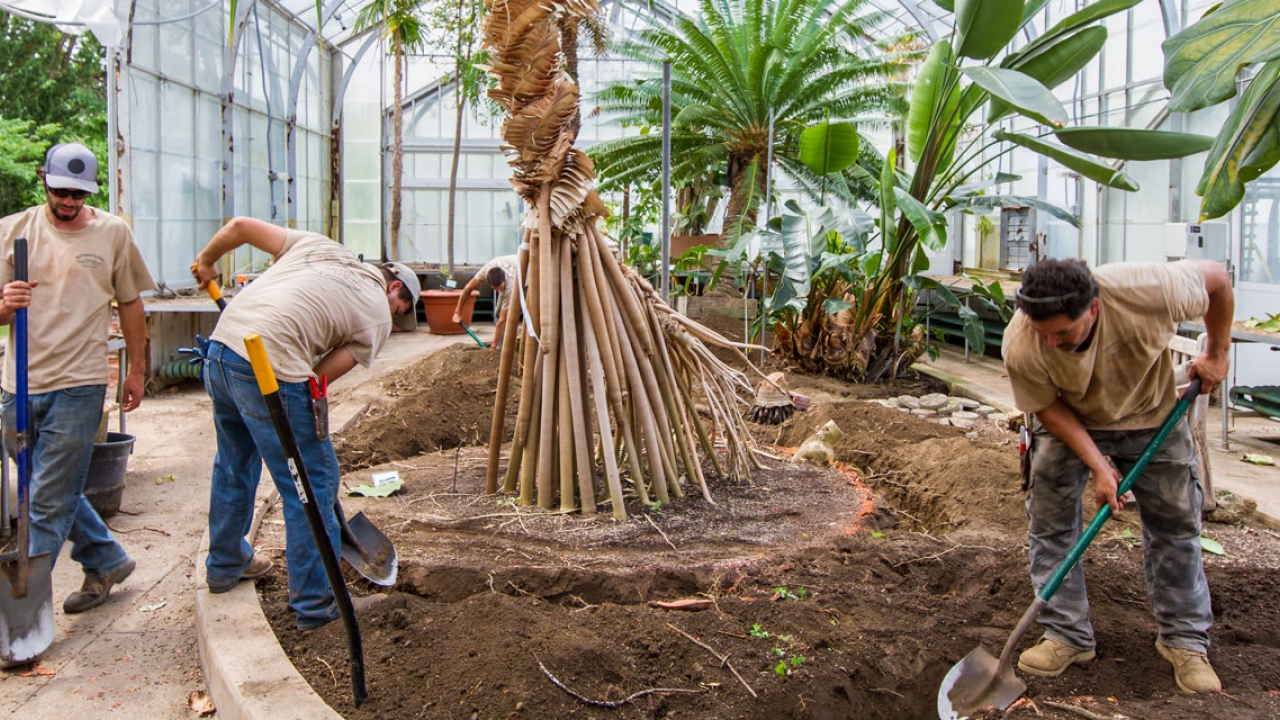From the Greenhouses to the Science Center: Wellesley’s Traveling Trees

Moving is never easy. It’s especially hard if you’re moving trees, some of which are two stories tall and nearly 100 years old. How do you extricate them from the greenhouses where they’ve lived for decades? And how do you transfer them to a new location? Those were the challenges facing Wellesley College Botanic Gardens (WCBG) staff in late July when they had to transport seven large specimens from the Margaret C. Ferguson Greenhouses, which will be torn down soon, to the Science Center. (An eighth was moved to a greenhouse on the Hunnewell Estate, next door to Wellesley, where many smaller potted plants will be housed as well.)
As Gail Kahn, assistant director of the WCBG, said, “It took a village”—including a team of professional tree movers and staff members from various departments—to complete the massive undertaking, as well as a crane and a Bobcat compact excavator.
Also required? Some creative thinking. For example, a few weeks before the move, Kahn and Kristina Niovi Jones, director of the WCBG, tried to find pots and pot saucers large enough to hold the plants, whose root systems are three to six feet wide. Containers that large were not available, so Jon Hall, a carpenter who works for Facilities, made pots from wood and lined them with plastic. The horticulture staff purchased several kiddie pools to use as pot saucers, which allow for drainage of excess water and help maintain humidity near the plants.
The staff faced another problem: Some of the plants were too wide to fit through the greenhouse doors, and others were as tall as the peak of the greenhouse roof. Facilities had to cut a 6-by-8-foot section from one wall of the Desert House and an 8-by-10-foot area from the wall of the Tropic House.
When the move began on July 17, the tree removal team began digging up the plants one by one and trimming their roots—which had to be less than six feet wide to pass through the doorways of the Science Center. The roots were balled and wrapped in burlap, then the plants were transported to their new residence. Some were brought by the Bobcat excavator to the Faroll Focus on the first floor, near the Leaky Beaker café. Others were lowered by crane onto the building’s roof and then brought to the penthouse (balcony) level, where they were anchored by at least two ropes to surrounding structures.
“The screw pine (Pandanus utilis) in particular was a bit of a challenge because it stands two stories high, with stilt-like roots that look like an insect trying to crawl out of its pot,” said Kahn.
Once the plants were in their new pots, the burlap was removed from their roots, and horticulturists Tony Antonucci, Tricia Diggins, and David Sommers, accompanied by summer workers Suong Tran (head cook at Tower) and Dunn Morgan, helped add barrel after barrel of soil to the pots. “That was a big, heavy job,” said Kahn. Sommers documented the entire process with numerous photographs.
By the time the move was completed, on July 21, plants that were once tucked away in the greenhouses had taken center stage. Faculty, staff, and students stopped to admire the plants, which range from 10 feet to 20 feet tall and can be viewed from multiple levels of the center. Among the plants are a Guadalupe palm (Brahea edulis), which is rare in its native habitat; a 13-year-old cannonball tree (Couroupita guianensis) that produces fragrant flowers; a century-old cycad (Cycas media) that dates from the opening of the Ferguson Greenhouses; and a 40-year-old banyan tree (Ficus benghalensis), a strangler fig that can grow a canopy as wide as two acres. (Wellesley’s will be well-pruned to keep it under control.)
“I always thought these plants were big and amazing. Now you can really see how big and amazing these guys are,” said Kahn.
“Bringing these trees indoors, to a place where you can see into the canopy, from the upper floor balconies, gives a whole new perspective on them,” said Jones. “There’s a new branch just starting on the screw pine that we can watch develop up close. Plants have such amazing forms that reward a closer look!”
Jones adds that when the new Global Flora greenhouses are constructed, they will feature a bridge walk along one side of the plants’ canopy. “So this is a sneak preview of what that will be like.”



